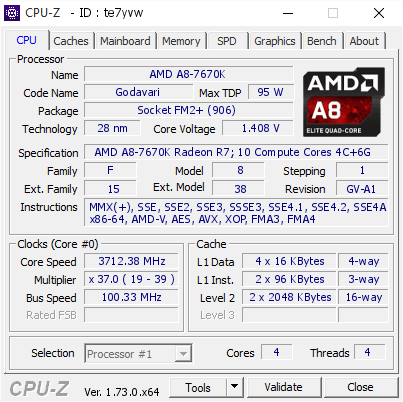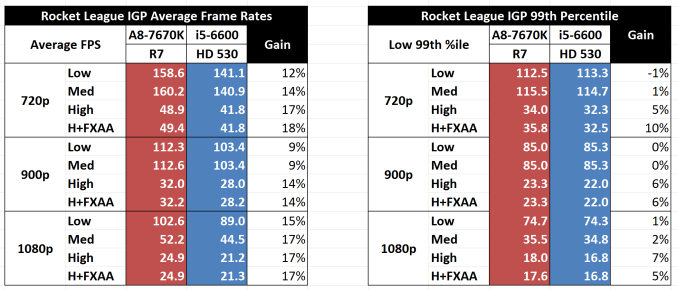The AMD A8-7670K APU Review: Aiming for Rocket League
by Ian Cutress on November 18, 2015 8:00 AM ESTAMD A8-7670K Conclusion
We have tested all of the new AMD APUs as they have trickled into the market, but there are a few obvious points that come up from comments and forums when we discuss them. To start, the base architecture in these APUs, though part of the Kaveri or Kaveri Refresh family, debuted in January 2014, making it nearly two years old. The underlying design that has been iterated upon three times for Kaveri — Bulldozer — is now four years old, released in October 2011. For all intents and purposes, because these processors are AMD’s latest desktop offerings, they are compared to Intel’s latest counterparts.
Despite AMD’s push into using their heterogeneous system architecture platform as a way to accelerate day-to-day tasks that involve any vector calculations (JPEG decode, video playback), as most benchmark workloads will show, the AMD APUs come out slower on the pure CPU aspect, and they're power-hungry due to the 28-nm lithography node on which they are produced (particularly compared to Intel's latest 14-nm node). I was at an event earlier this year where a technology journalist told AMD up front that they considered the 28-nm processors hot and slow, and that users were not likely to be interested in them.
To combat what AMD sees as an pervasive dislike of the platform, AMD has been focusing on three talking points in their marketing message in order to communicate the areas where they believe they have an advantage. This is, by its nature, a bit of a spiel on AMD's part, but at the same time, there are some nuggets of truth in these claims, as illustrated by our benchmark results.
AMD's first talking point is, of course, price. AMD considers their processors very price-competitive, especially for low-cost systems when you consider performance as a function of total system cost. AMD's second talking point is on the power-consumption issue. For some time now, AMD's line has been that they don't believe that most users think about power consumption when gaming, suggesting that for the markets they are targeting, it might not be an issue to begin with. AMD's third talking point is on graphics performance, where AMD believes that their integrated graphics (or dual graphics with an R7 discrete card) will easily win on price and performance, especially for e-sports titles currently favored by budget gamers.
For the validity of AMD's talking points, we can verify Nos. 1 and 3 with our benchmarks, dollar for dollar. Especially when a dual graphics profile for a game exists, the gaming performance will be better for the same price. However, one might argue that relatively few users use a PC just for games, and items such as JavaScript/HTML5 performance for social media interaction is also important, with this being the main barrier low-frequency APUs have to compete against (in comparison to equally priced Intel counterparts). As for talking point No. 2, it's debatable whether users really care about the power consumption of their system during gaming. A personal thought for this would be if the system fans were to spin up, then maybe it would play on the mind, especially if the system is being used to watch a film or play music. But typically, users concerned with this sort of power consumption tend to be over 25 years old and can afford to be more selective with their purchases, as opposed to e-sports gamers on tight budgets. Nevertheless, some users will wholeheartedly disagree.
Ultimately these points lie at the heart of AMD’s dilemma. On one hand, many users will avoid an APU due to specifications or experience, no matter the budget. On the other hand, AMD has a tight space to work in, but there are areas where their APUs hold an edge over Intel's CPUs. The trick for AMD right now is convincing skeptical buyers of this.
If we look beyond today’s review, everyone who cares about CPU performance is hoping that AMD's new microarchitecture in 2016, Zen, allows AMD to catch up to Intel in raw CPU performance. At present, AMD has released slides claiming a 40% increase in IPC for their new design. If AMD can deliver on their performance goals then this should significantly improve their standing as far as x86 CPU performance goes, though this will initially be aimed at the high-performance market. Otherwise for budget users or the e-sports crowd, we will have to wait and see what the Zen microarchitecture brings and how it will be implemented for APUs.
Until then, AMD's APUs still win for that Rocket League style of player, beating any equivalent Intel implementation at the same price. The A8-7670K, with a minor recent discount to $100, is essentially the center point of that APU stack, on AMD's latest process design tweaks. We overclocked our sample to 4.6 GHz, but your mileage may vary.
On a personal note, as you might expect, I build systems for my family. My father, who wanted an audio workstation, had a big enough budget to consider something with many cores and hyperthreading, focusing on low audio latency and a configuration that used software that took advantage of that. I've mentioned in these reviews that I outfitted my 15-year-old cousin-in-law with an APU and a discrete card for a small cheap dual graphics system that probably cost $400 or so. With it, he does school work, talks to his friends and plays a range of MOBA and MMO games without issues. He's rather happy with it.
For future reference, all of our regular benchmark results can also be found in our benchmark engine, Bench.














154 Comments
View All Comments
tipoo - Wednesday, November 18, 2015 - link
The FPS by percentile graph is nice, is that new to AT?Ian Cutress - Wednesday, November 18, 2015 - link
Ryan does some percentile data in GPU reviews, and we did some stuff around the CFX/SLI sync issues. But we did the FPS by percentile graphs a bit in the Fable Legends testing. Some benchmarks provide the per-frame data by default, others do not (depends on how you're polling), and then there's some post-processing which takes longer than you think. It's a sort of graph that only 3/4 lines can be on it without going overboard.tipoo - Wednesday, November 18, 2015 - link
Cool. I like it.tipoo - Wednesday, November 18, 2015 - link
For GTA V, it looks like dual graphics on the same settings gives lower framerates than the 240 alone? Is that right? Other than that you see a pretty nice boost with it.jaydee - Wednesday, November 18, 2015 - link
I noticed that too and was wonderingyannigr2 - Wednesday, November 18, 2015 - link
APUs are excellent solutions for systems without graphics. If you are going to add a graphics card, then excluding dual graphics, APUs seem much less attractive. A8 7600 is in my opinion the best cheap APU you can get for a system without a discrete graphics card, 78X0K are an option ONLY when you are definitely never going to add a graphics card and you want the best possible integrated GPU, without having to rob a bank for an Iris GPU.But even when AMD's APUs are the best option, people will still rush to make people avoid them. That's AMD's doing and we can only blame them. Recently someone asked for a cheap system to play an old FPS game. Videos on youtube where showing that an A8 7600 could play the game. That didn't stopped people rushing in the thread to insist that, that game wasn't going to be fun with under 140 fps. Yes, 140 fps. They didn't considered gaming peripherals, or a gaming monitor important, only 140 fps. Anything to "save" someone from an AMD APU and send him to Intel. Even if this means convincing someone paying at least $80-$100 that he may not have. At the same time the same persons blame ONLY AMD for the lack of competition.
Dribble - Wednesday, November 18, 2015 - link
AMD's solutions appeal to pretty well no one. If you don't have an add in gpu chances are you don't want to game in which case Intel wins hands down. If you want to game you'll buy a cheap graphics card in which case Intel wins hands down.The mythical buying market that want to game on a desktop but can't even afford a basic add on card just doesn't exist. We know this because AMD have been trying to sell apu's like this one for years now and no one is buying.
Yorgos - Wednesday, November 18, 2015 - link
That's false,I am gaming in 1080p and I play many games above 25fps with almost high settings.
A good example is skyrim with the high definition mod that you can get from steam and I am constantly at 25 fps.
All this was tested on my 8750k and 2400 MHz ram. What's your point of reference?
OTOH, there is a shitload of ppl that play only MOBA games or FPS like cs where you don't need to spend 300 or more in a system. A 150$ system can get you constant 30 fps w/o a sweat.Plus you get a discrete grade GPU embedded with your cpu and you get all the goodies and the high quality drivers/support the discrete gpus get. Intel has none of the previous.
Dribble - Wednesday, November 18, 2015 - link
I would point you to AMDs CPU sales. No one is buying, AMD have been trying to sell cpu's like this one for years and failing - the market isn't there.medi03 - Thursday, November 19, 2015 - link
I would point you to the fact that Netburst outsold superior Athlon 64s 4 to 1.